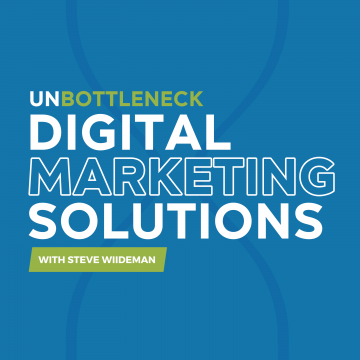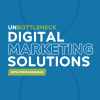Podcast: Play in new window | Download
In this episode of the Unbottleneck Podcast, Steve Wiideman is joined by digital marketing expert and advertising specialist, Dennis Yu, to dive into creating and tracking successful Facebook advertising campaigns.
About Our Guest: Dennis Yu
Dennis Yu is CEO of BlitzMetrics, a digital marketing company working with schools to train young adults, offering courses, implementation, and consulting. He has managed campaigns for enterprise clients like The Golden State Warriors, Nike, and Rosetta Stone.
Dennis is an internationally recognized lecturer in digital marketing and co-author of “Facebook Nation” – a textbook taught in over 700 colleges and universities.
Sponsored by Ryte
Featured in this episode:
- Maximizing Facebook Video Ads
- Tracking Performance on Facebook
- The 3-Stage Social Media Funnel
- Facebook Tracking vs 3rd Party Tools
Maximizing Facebook Video Ads
Just like Google dominates search, Facebook dominates social. If you are a business owner, you should be utilizing Facebook ads to drive conversion.
Short-form video content has quickly become the new standard for social media and it is not going away anytime soon. While it can be intimidating to start tackling video content, it is actually quite simple. You don’t have to approach video content with the expectation of being a huge personality, but instead, you can approach it in a way that feels authentic to you.
Video content that often does well are clips that capture your normal day-to-day routines. Some examples include a cosmetic surgeon sharing a clip of a liposuction procedure or a real estate agent giving a tour of a luxury property. It is as easy as picking up your phone and recording. The great thing about taking this informal approach is that it doesn’t take much effort. You can simply take about an hour/week to capture content!
Since the pandemic, people have become more invested in the human experience captured by a phone rather than a thousand dollar production. So focus on telling a story that resonates with people.
Pro-Tip: Give your post a little boost! Small businesses typically have a difficult time getting engaged on their post. You can spend $1 per day for 7 days to get more eyes on your post and increase engagement.
Facebook Tracking
If you have an iPhone, you have probably recently seen a pop-up message from Facebook asking for permission to track your activity. This pop-up message gives you the option to opt-in or out of digital tracking which affects efforts for ad targeting.
According to Yu, 95% of people have already opted out of tracking. So what does that mean for advertisers?
The good news is that all is not lost. Businesses can still create targeted ads, but based on first-party data which can include CRM tools, Shopify, Google Analytics, WordPress, etc. Technology systems have become so advanced to the point where they will do the work for you based on ongoing conversions.
Build it and They Will Come: Three-Stage Social Media Funnel
One of the biggest differences between Google and social media is intent. With Google, users initiate their search to solve their problem or need right away (i.e emergency plumber, car repair, food near me).
However, on social media there is no way to track what a user’s need is because oftentimes they are not scrolling through social media with the intent to solve a problem. Therefore, we have to create that intent organized by a three-stage funnel: awareness, consideration, and conversion.
This three-stage funnel is not exclusive to Facebook. Other platforms such as Tik Tok, LinkedIn, and Twitter use this same model because social media has become a sophisticated, data-driven, measurable word-of-mouth channel. Having this type of funnel is not about targeting a specific group of people, but it’s about putting your content out into the world and catering to those that engage with it.
Awareness = Why?
In the initial awareness phase, you develop your “why”, or your story that hooks people.
It’s not about going into great detail about your product, service, or process, but instead, it’s about giving your audience a glimpse of who you are, your credentials, and your values with little snippet videos that can be as short as 15 seconds.
Oftentimes, people may not know that they have a problem or a need until you show up in the space as an authority. So this is your opportunity to show up in a way that allows people to access who you are and what you do in order to create familiarity.
Consideration = How?
The consideration phase is where you craft your “how”?
This is where prospects are actively assessing additional information to solve a problem or a need. By posting one-minute video clips that answer relevant questions in your industry, you can establish authority while generating the interest of prospective buyers.
Therefore in this phase, you’ll want to maximize sharing useful information (“how to’s” or “did you know”) that will make people want to learn more.
Conversion = What?
The final stage is conversion, or your “what,” which is the ultimate goal.
This is the stage where you include a Call to Action that will encourage users to convert to buyers. Some popular calls to action include downloading a guide, signing up for a webinar, filling out a form for a consultation.
What makes this stage effective is not about being a good salesperson, but progressing people from your why to your how.
Going Straight to the Source for Tracking
With so many third-party tools available to track data, such as Buffer and Hootsuite, you want to ensure that you’re getting your hands on the most accurate data to help drive your advertising campaign.
The best way to get Facebook data is to go straight to the source: Facebook! Facebook is the ultimate tool to use because they have all the data you need to drive higher engagement. From Ads Manager to the local business page, Facebook provides all the necessary tools to give you an overview of the appropriate audience for targeting and retargeting purposes.
Keep up with the latest in digital marketing strategies and online advertising practices. Follow Steve on LinkedIn!




